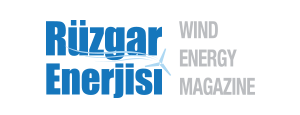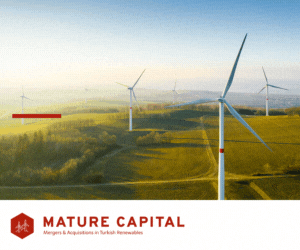Manufacturers of wind turbines
A case study and an applicatıon of IEC61400-12-1:2017

İskender Kökey, Z. Haktan Karadeniz, Sercan Acarer, Alpaslan Turgut
General summary
Due to the increasing demand of energy and rapidly developed wind turbines technology, rotor swept areas and hub heights of horizontal axis wind turbines (HAWT) are getting bigger. As a result of development in the wind industry, each HAWT requires more land space between each other to decrease overall wake losses of wind power plants (WPPs) which necessarily increases the land necessity for WPPs. Each HAWT must be spaced 4-6 rotor diameters away in the cross-wind direction and 8 – 10 rotor diameters away in the down-wind direction to its neighbor HAWT for minimizing wake effects and maximizing WPP performance. Required WPP land sizes are increasing with the increasing of each individual turbine power and it ends up with the 3 – 5 W power output for each meter square of WPP site for HAWTs included WPPs. It is known that footprint-power-density can be increased dramatically by using vertical axis wind turbines (VAWTs) working in groups and pairs instead of HAWTs. We present an investigation of energy interaction of VAWTs working in pairs as a case study in a test site located in Izmir City of Turkey by the following suggestions of IEC 61400-12-1:2017 standard. It is aimed to present a case study of an innovative solution for new age WPPs.

Method
A near-shore site located in Çaltılıdere region of İzmir City of Turkey is selected for the power performance measurements. Site characteristics are defined by employing more than a year-long wind measurements at 60m. height in this site. Two H-Darrieus type VAWTs both having a 2.6m rotor diameter, 2m rotor height, 7.15m hub height, and 0.5 kW output power, are used for field study. The effect of the distance between the turbines on power performance of VAWTs will be performed by the suggestion of Annex H of IEC61400-12-1:2017 standard. Therefore, the wind measurements will be repeated at a hub-height-station. Firstly, the field study of a stand-alone HDarrieus type VAWT will be done then, two VAWTs working in pairs will be investigated.

Results
Up until now, results show that test site has 4,53 m/s mean wind speed and 0.94 m/s mean turbulence intensity at 7,15 m height. This relatively turbulenced, near-shore site promises a wide range of wind speed with a different rate of turbulence intensity during the experiments. The first phase of the study includes power performance measurement of a stand-alone HDarrieus type VAWT. It is expected to receive valuable results for a better understanding of wake effect of stand-alone VAWT and energy interaction of VAWTs working in pairs in the results of ongoing experiments. Another expected result of the ongoing study until the conference is demonstrating the more efficient energy converting capability of VAWTs then HAWTs under the highly turbulenced wind conditions.

Conclusions
One of the most important question for the large-scale, HAWTs included WPPs is land acquisition. It’s getting become a serious problem to find big enough land for large-scale WPPs to siting turbines with the minimum energy interaction to avoid wake losses. On the other hand, VAWTs promise much more efficient WPPs with closely-located siting strategy due to their aerodynamic behavior of positively effected by the wake of its own neighbor. Whats more, using small-scale VAWTs at the inside of the operational wind farms is also an interesting concept for increasing footprint power density of existing WPPs and it called “bush and tree” concept. VAWTs, specially Darieus types working in pairs, are promising a bright future for the wind industry.
 Learning objectives
Learning objectives
VAWTs are one of the most promising topics for the wind industry in the past decade due to the importance of small-scale wind turbines and the necessity of effectively used land spaces for large-scale WPPs. There is a very limited case study in both literature and industrial applications to define energy interaction and energy conversion mechanism of VAWTs clearly. This study includes valuable experimental results of the power performance measurement of a stand-alone, Darieus type VAWT and contributes industrial knowledge. On the other hand, the study includes a unique application of a newly updated international standard of IEC61400-12-1:2017. Attended delegates will have the opportunity to follow up a case study and step-by-step application of the newly updated industrial standard.
-

 Events5 years ago
Events5 years agoCanada and Turkey women working in the renewable energy sector in met
-

 Manufacturers of wind turbines5 years ago
Manufacturers of wind turbines5 years agoGE’s Haliade-X 12 MW prototype to be installed in Rotterdam
-

 Operations and Maintenance6 years ago
Operations and Maintenance6 years agoGENBA is on the rise; another milestone passed by in global existence
-

 Genel8 years ago
Genel8 years agoEWT launches the DW61, It’s most efficient and high energy producing wind turbine
-

 Genel9 years ago
Genel9 years agoInternet of things will empower the wind energy power plants
-

 Turbine Manufacturing6 years ago
Turbine Manufacturing6 years agoİğrek Makina focused on developing and producing Machine Tools and Wind Energy Turbines
-

 Energy management systems5 years ago
Energy management systems5 years agoDemand/Supply – Renewable energy with guarantees of origin (GO)
-

 Events5 years ago
Events5 years agoKey Players from 10 Nations will Show Their Strong Positions at APWEE
-

 Manufacturers of wind turbines5 years ago
Manufacturers of wind turbines5 years agoThe Nordex Group receives first order for Delta4000 turbines from the USA
-

 Manufacturers of wind turbines4 years ago
Manufacturers of wind turbines4 years agoENERCON installs E-160 EP5 prototype
-

 Genel8 years ago
Genel8 years agoZorlu energy envisages a bold new future based on renewables
-

 Manufacturers of wind turbines5 years ago
Manufacturers of wind turbines5 years agoENERCON and Lagerwey together develop two new WEC types



